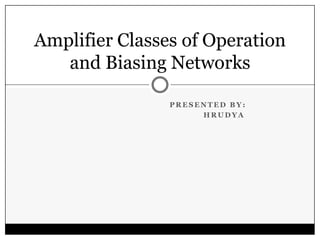
Amplifier classes of operation and biasing networks latest
- 1. Amplifier Classes of Operation and Biasing Networks PRESENTED BY: HRUDYA
- 2. Amplifier Classes Amplifiers are classified according to the portion of the input cycle the active device conducts current This is referred to as the conduction angle and is expressed in degrees Single-ended audio amps are operated in Class A where the device conducts for 360° Push-pull amps can be a Class B if one of the two devices is conducting at all times Most audio power amps operate in Class AB - a compromise between Class A and Class B
- 3. Class A The active device conducts current 100% of time . Current flows in the output circuit throughout the input signal period. Conduction angle (output voltage swing) is 360 degree. Operating point is established at the centre of the load line . Therefore practically no distortion of amplified output But half of the supply voltage, drop across the transistor and current through the transistor is half of the saturation value. Hence efficiency of class A amplifier is only 50%
- 4. Class B Output current flows only for half the period of the input signal. Conduction angle is only 180 degree. Operating point is selected at or very near the cut-off point on the load line . There is distortion of output voltage wave due to clipping. Power drain is much less .(Since during the half cycle of the input signal, when there is no conduction, transistor bias current is zero.) Hence efficiency of class B amplifier is only 78.5%
- 5. Class C Output current flows less than half the period of the input signal. Conduction angle less than 180 degree.. There is maximum distortion of output voltage wave due to clipping. Power drain is much less Hence efficiency of Class C amplifier is almost 100%.
- 6. Class AB Output current flows for more than half the period of the input signal but not throughout the cycle. Conduction angle is more than 180 but less than 360 degree. Operating point is selected such that it is neither at cut-off nor at the centre of load line, but lies somewhere in-between . There is distortion of output voltage wave due to clipping. Hence efficiency of class B amplifier is more than 50% but less than 78.5%.
- 7. Load and power supply current waveforms as a function of conduction angle.
- 8. Contd.......
- 9. Biasing networks Biasing networks are needed to set appropriate operating conditions for active devices There are two types: • Passive biasing (or self-biasing) – resistive networks – drawback: poor temperature stability • Active biasing – additional active components (thermally coupled) – drawback: complexity, added power consumption
- 10. Passive biasing Simple two element biasing. blocking capacitors CB and RFCs to isolate RF path Very sensitive to collector current variations
- 11. Passive biasing Voltage divider to stabilize VBE Freedom to choose suitable voltage and current settings. (Vx, Ix) Higher component count, more noise susceptibility.
- 12. Active biasing Disadvantages of passive baising networks are Poor temparature stability Sensitive to changes in transistor parameters Base current of RF BJT (Q2) is provided by low-frequency BJT Q1 Excellent temperature stability (shared heat sink) High component count, more complex layout,Additional Circuit Board Space Added power requirements.
- 13. In all biasing networks , the operating conditions of the transistor at rf frequencies are entirely independent of dc configuration. At dc Capacitors - rep open circuit RFC - short circuit At ac Capacitors – short circuit RFC – open circuit
- 14. DC and RF Equivalent Circuits for the active biasing network.
- 15. FET biasing
